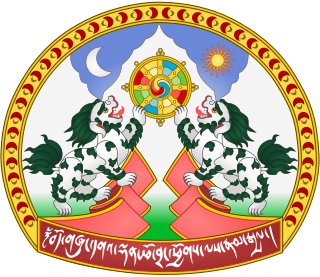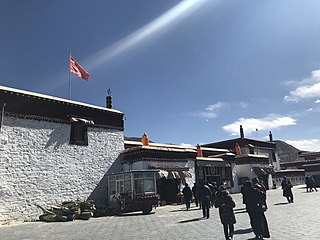
Chökyi Gyalpo, also referred to by his secular name Gyaincain Norbu or Gyaltsen Norbu, is considered the 11th Panchen Lama by the government of the People's Republic of China (PRC). He is also the vice president of the Buddhist Association of China. Gyalpo is considered by critics to be a proxy of the Chinese government.

Güshi Khan was a Khoshut prince and founder of the Khoshut Khanate, who supplanted the Tumed descendants of Altan Khan as the main benefactor of the Dalai Lama and the Gelug school of Tibetan Buddhism. In 1637, Güshi Khan defeated a rival Mongol prince Choghtu Khong Tayiji, a Kagyu follower, near Qinghai Lake and established his khanate in Tibet over the next years. His military assistance to the Gelug school enabled the 5th Dalai Lama to establish political control over Tibet.

The 5th Dalai Lama, Ngawang Lobsang Gyatso was recognized as the 5th Dalai Lama, and he became the first Dalai Lama to hold both Tibet's political and spiritual leadership roles. He is often referred to simply as the Great Fifth, being the key religious and temporal leader of Tibetan Buddhism and Tibet. He is credited with unifying all of Tibet under the Ganden Phodrang, after Gushri Khan's successful military interventions. As an independent head of state, he established priest and patron relations with both Mongolia and the Qing dynasty simultaneously, and had positive relations with other neighboring countries. He began the custom of meeting early European explorers. The 5th Dalai Lama built the Potala Palace, and also wrote 24 volumes' worth of scholarly and religious works on a wide range of subjects.

Drepung Monastery, located at the foot of Mount Gephel, is one of the "great three" Gelug university gompas (monasteries) of Tibet. The other two are Ganden Monastery and Sera Monastery.

Losang Chö kyi Gyaltsen (1570–1662) was the fourth Panchen Lama of the Gelug school of Tibetan Buddhism and the first to be accorded this title during his lifetime.

The Namgyal dynasty was a dynasty whose rulers were the monarchs of the former kingdom of Ladakh that lasted from 1460 to 1842 and were titled the Gyalpo of Ladakh. The Namgyal dynasty succeeded the first dynasty of Maryul and had several conflicts with the neighboring Mughal Empire and various dynasties of Tibet, including the Tibet–Ladakh–Mughal War. The dynasty eventually fell to the Sikh Empire and Dogras of Jammu. Most of its known history is written in the Ladakh Chronicles.

Yumbu Lakhang or Yumbu Lakhar is an ancient structure in the Yarlung Valley in the vicinity of Tsetang, Nêdong County, the seat of Lhoka Prefecture, in Tibet.

The national anthem of Tibet, commonly referred to as "Gyallu", is a Tibetan patriotic song which serves as the de facto anthem of the Central Tibetan Administration.

The Emblem of Tibet is a symbol of the Tibetan government in exile. It combines several elements of the flag of Tibet, with slightly different artistry, and contains many Buddhist symbols. Its primary elements are the sun and moon above the Himalayas, which represent Tibet, often known as the Land Surrounded by Snow Mountains. On the slopes of the mountains stand a pair of snow lions. Held between the two lions is the eight-spoked Dharmacakra, represent the Noble Eightfold Path of Buddhism. Inside the wheel, the three-colored swirling jewel represents the practices of the ten exalted virtues and the 16 humane modes of conduct. The inscription on the swirling banner below is as follows: bod gzhung dga' ldan pho brang phyogs las rnam rgyal The Ganden Palace, located in Drepung monastery was the residence of the Dalai Lamas until the 5th Dalai Lama. After the 5th Dalai Lama had moved to the Potala in the mid 17th century the Tibetan Government created by him in 1642 became known as the "Ganden Phodrang" Government.
Tibet Times is a Tibetan-language newspaper founded in 1996 and published every ten days from Dharamshala, Himachal Pradesh, India, the residence of the 14th Dalai Lama. Besides, its newspaper publication, Tibet Times also have a Tibetan language website and also Mobile App which disseminates breaking, unbiased and informative news to its reader on a day-to day basis.

Tradruk Temple in the Yarlung Valley is the earliest great geomantic temple after the Jokhang and some sources say it predates that temple.
Lhamo Latso or Lha-mo La-tso is a small oval oracle lake where senior Tibetan monks of the Gelug sect go for visions to assist in the discovery of reincarnations of the Dalai Lamas. Other pilgrims also come to seek visions. It is considered to be the most sacred lake in Tibet.

Tsepon Wangchuk Deden Shakabpa was a Tibetan nobleman, scholar, statesman and former Finance Minister of the government of Tibet.

Trülku Drakpa Gyeltsen (1619–1656) was an important Gelugpa lama and a contemporary of the 5th Dalai Lama (1617–1682). His Seat was the upper residence of Drepung Monastery, a famous Gelug gompa located near Lhasa.

The Phagmodrupa dynasty or Pagmodru was a dynastic regime that held sway over Tibet or parts thereof from 1354 to the early 17th century. It was established by Tai Situ Changchub Gyaltsen of the Lang family at the end of the Yuan dynasty. The dynasty had a lasting importance on the history of Tibet; it created an autonomous kingdom after Yuan rule, revitalized the national culture, and brought about a new legislation that survived until the 1950s. Nevertheless, the Phagmodrupa had a turbulent history due to internal family feuding and the strong localism among noble lineages and fiefs. Its power receded after 1435 and was reduced to Ü in the 16th century due to the rise of the ministerial family of the Rinpungpa. It was defeated by the rival Tsangpa dynasty in 1613 and 1620, and was formally superseded by the Ganden Phodrang regime founded by the 5th Dalai Lama in 1642. In that year, Güshi Khan of the Khoshut formally transferred the old possessions of Sakya, Rinpung and Phagmodrupa to the "Great Fifth".

Kundeling Monastery is a Tibetan Buddhist monastery in Lhasa, Tibet, China. It was founded around 1794, and follows the Gelug school. The head of the monastery belongs to a lineage of incarnations that dates back to 1402. There is dispute over the current incarnation. The monastery was destroyed during the Cultural Revolution, then rebuilt in the 1980s.
The Changkya Khutukhtu was the title held by the spiritual head of the Gelug lineage of Tibetan Buddhism in Inner Mongolia during the Qing dynasty.

There were several Mongol invasions of Tibet. The earliest is the alleged plot to invade Tibet by Genghis Khan in 1206, which is considered anachronistic; there is no evidence of Mongol-Tibetan encounters prior to the military campaign in 1240. The first confirmed campaign is the invasion of Tibet by the Mongol general Doorda Darkhan in 1240, a campaign of 30,000 troops that resulted in 500 casualties. The campaign was smaller than the full-scale invasions used by the Mongols against large empires. The purpose of this attack is unclear, and is still in debate among Tibetologists. Then in the late 1240s Mongol prince Godan invited Sakya lama Sakya Pandita, who urged other leading Tibetan figures to submit to Mongol authority. This is generally considered to have marked the beginning of Mongol rule over Tibet, as well as the establishment of patron and priest relationship between Mongols and Tibetans. These relations were continued by Kublai Khan, who founded the Mongol Yuan dynasty and granted authority over whole Tibet to Drogon Chogyal Phagpa, nephew of Sakya Pandita. The Sakya-Mongol administrative system and Yuan administrative rule over the region lasted until the mid-14th century, when the Yuan dynasty began to crumble.

Voice of Tibet is a radio station based in Norway transmitting shortwave radio programmes in the Tibetan language as well as Mandarin Chinese. The station began broadcasting on 14 May 1996 and was founded by three Norwegian NGOs: Norwegian Human Rights House, The Norwegian Tibet Committee and Worldview Rights. Its broadcasts target Tibet and China as well as India, Bhutan and Nepal. It receives funds from the United States National Endowment for Democracy.

Pawo Tsuglag Threngwa (1504–1566), the second Nenang Pawo, was a Tibetan historian of the Karma Kagyu. He was a disciple of Mikyö Dorje, 8th Karmapa Lama. He was the author of the famous mkhas pa'i dga' ston, A Scholar's Feast, addressing history of Buddhism in India and its spread in Tibet, as well as the history of Tibet.
Of Tsuklak Trengwa's many students, his chief disciples included the Ninth Karmapa Wangchuk Dorje, the Fifth Zhamar Konchok Yenlag, and the Third Tsurpu Gyeltsab, Drakpa Peljor.
















